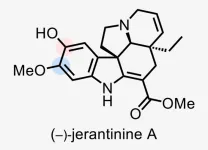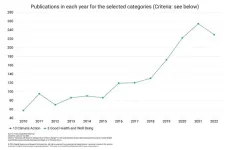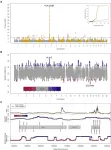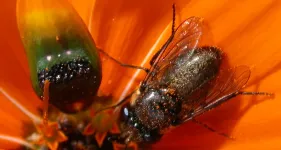Newly discovered cell in fruit flies is essential for touch sensation
2023-03-23
(Press-News.org) The Francis Crick Institute press release
Under strict embargo: 16:00 GMT Thursday 23rd March
Peer reviewed
Experimental
Cells
Researchers at the Francis Crick Institute have uncovered a key role for a new type of cell in touch detection in the skin of the fruit fly.
Touch allows animals to navigate their environment by gathering information from the outside world. In their study published today in Nature Cell Biology, Dr Federica Mangione and Dr Nicolas Tapon shed light on how touch-sensitive organs assemble during development.
In particular the team studied the development of mechanosensory bristles – tactile hairs found on the skin of the fruit fly – which are similar to hair follicles in mammals.
They found that bristles send signals to neighbouring epidermal cells to recruit a new cell type, named the F Cell, which participates in touch sensing.
Using advanced imaging techniques, the team were able to characterise the structure and features of the F-Cell, finding that they adopt a unique shape which wraps around the tactile bristle.
Using electrophysiological recordings – a technique to measure the activity of a neuron in response to a stimulus – the researchers showed that F-Cells are important for bristle function. When they removed the F-Cells from the epidermis, neuron firing in response to touch was strongly reduced.
Using behavioural assays – a way to measure animal behaviour – flies lacking F-Cells were also unable to scratch themselves with their leg in response to lightly touching the bristles, showing insensitivity to touch.
Dr Federica Mangione, Postdoctoral Fellow at the Crick and first author said: “The whole journey of identifying, characterising and even naming a new cell type was very exciting. I noticed that one epidermal cell next to each bristle became remarkably different from its neighbours, then was incorporated into the bristle itself as it changed shape and wrapped around the other cells. Showing it is required for touch sensation in the adult fly was truly a thrilling moment!”
Dr Nic Tapon, Group Leader of the Apoptosis and Proliferation Control Laboratory at the Crick said: “We used the fly tactile bristle as it’s an accessible way to understand the sense of touch – bristles fulfil a similar role to our own hair follicles. We were very surprised to find a new cell type as the epidermis is a well-studied structure, although how these structures are built during development is not well understood. To answer the all-important question of whether the F-Cell is important for touch sensing, through collaborative working at the Crick and Oxford University, we were able to bridge two different fields – epidermal development and sensory biology – to give a very clear answer.”
The sense of touch from a developmental perspective is not well understood, and decline in touch sensing is a major problem during ageing and neurodegenerative conditions like Alzheimer’s disease. People with autism spectrum disorder can also experience altered touch perception.
By finding that specialised non-nerve cells are crucial for touch sensitivity in the fly, the researchers hope this can add to our understanding of touch in mammals and eventually humans.
Dr Federica Mangione said: “We still have a lot to learn about how the sense of touch develops and the role of specialised cells in touch sensing. There are specialised epidermal cells in mammals, like the Merkel cells, but we don’t yet know if there’s a direct equivalent to the F-Cells. More research is needed to understand the biology of these exciting cell types and how they participate in sensing touch – both in healthy people and those living with conditions impacting their touch perception.”
-ENDS-
For further information, contact: press@crick.ac.uk or +44 (0)20 3796 5252.
Notes to Editors
Reference: Mangione, F. et al. (2023). Co-option of epidermal cells enables touch sensing. Nature Cell Biology. 10.1038/s41556-023-01110-2
The Francis Crick Institute is a biomedical discovery institute dedicated to understanding the fundamental biology underlying health and disease. Its work is helping to understand why disease develops and to translate discoveries into new ways to prevent, diagnose and treat illnesses such as cancer, heart disease, stroke, infections, and neurodegenerative diseases.
An independent organisation, its founding partners are the Medical Research Council (MRC), Cancer Research UK, Wellcome, UCL (University College London), Imperial College London and King’s College London.
The Crick was formed in 2015, and in 2016 it moved into a brand new state-of-the-art building in central London which brings together 1500 scientists and support staff working collaboratively across disciplines, making it the biggest biomedical research facility under a single roof in Europe.
http://crick.ac.uk/
END
ELSE PRESS RELEASES FROM THIS DATE:
2023-03-23
A protein complex prevents the repair of genome damage in human cells, in mice and in the nematode Caenorhabditis elegans, a team of researchers at the University of Cologne has discovered. They also successfully inhibited this complex for the first time using a pharmaceutical agent.
“When we suppress the so-called DREAM complex in body cells, various repair mechanisms kick in, making these cells extremely resilient towards all kinds of DNA damage,” said Professor Dr Björn Schumacher, Director of the Institute for Genome Stability in Aging ...
2023-03-23
Plants produce all types of curious chemicals. Some deter predators. Some smell wonderful. Some even have medicinal value. One of these hidden gems is (–)-jerantinine A (JA), a molecule with remarkable anticancer properties, produced by a plant called Tabernaemontana corymbosa. Unfortunately, access to this Malaysian jungle plant and its promising chemical compound has been limited. Until now.
Cold Spring Harbor Laboratory (CSHL) chemists, led by Professor John E. Moses, have created a way to safely, quickly, and sustainably synthesize JA in the lab. To cancer biologists at CSHL, this breakthrough could mean future ...
2023-03-23
Whether it’s diseases from bats, birds, pigs, or mosquitoes, climate change brings with it an increased risk of animal-borne (or “zoonotic”) diseases that can transmit to humans.
Digital Science, a technology company serving stakeholders across the research ecosystem, has today released its analysis of the global research response to climate change and zoonotic diseases, in the context of the United Nations’ Sustainable Development Goals (SDGs) on climate and health.
Using data from Dimensions, Dr Briony Fane, Ann Campbell and Dr Juergen Wastl from Digital Science have explored published research, ...
2023-03-23
Researchers have used pluripotent stem cells to make thymus organoids that support the development of patient-specific T-cells, researchers report March 23rd in the journal Stem Cell Reports. The proof-of-concept work provides the basis for studying human thymus function, T-cell development, and transplant immunity.
“We have established the framework for further basic science and translational research interrogating human thymus development and function in vitro, and in a patient-specific manner,” says senior author Holger Russ, of the University ...
2023-03-23
When early Stone Age farmers first moved into Europe from the Near East about 8,000 years ago, they met and began mixing with the existing hunter-gatherer populations. Now genome-wide studies of hundreds of ancient genomes from this period show more hunter-gatherer ancestry in adaptive-immunity genes in the mixed population than would be expected by chance.
The findings, reported in Current Biology on March 23, suggest that mixing between the two groups resulted in mosaics of genetic variation that were acted upon by natural selection, a process through which all organisms, including humans, adapt and change ...
2023-03-23
A male fly approaches a flower, lands on top of what he thinks is a female fly, and jiggles around. He’s trying to mate, but it isn’t quite working. He has another go. Eventually he gives up and buzzes off, unsuccessful. The plant, meanwhile, has got what it wanted: pollen.
A South African daisy, Gorteria diffusa, is the only daisy known to make such a complicated structure resembling a female fly on its petals. The mechanism behind this convincing three-dimensional deception, complete ...
2023-03-23
Francis Crick Institute press release
Under strict embargo: 15:00hrs GMT 23 March 2023
Peer reviewed
Observational study
People
Research from the Francis Crick Institute published today in Current Biology has revealed that diversity in genes coding for immunity may have facilitated adaptation to farming lifestyles in prehistoric periods.
Researchers at the Ancient Genomics Laboratory at the Crick studied available genome-wide DNA from 677 individuals dating to Stone Age Europe, spanning the movement of Neolithic farmers from the Near East into Europe about 8000 years ago, where they mixed with Mesolithic hunter-gatherers already in Europe.
They were interested in whether ...
2023-03-23
Being vaccinated against Covid halves people’s risk of developing long Covid, according to new research from the University of East Anglia.
Long Covid still affects some two million people in the UK, and new research published today reveals the risk factors associated with developing the condition.
Overweight people, women, smokers and those over the age of 40 are also more likely to suffer from long Covid according to the study - which includes more than 860,000 patients and is thought to be the largest of its kind.
The study also finds that co-morbidities such as asthma, COPD, Type 2 Diabetes, coronary heart disease, immunosuppression, anxiety ...
2023-03-23
About The Study: This systematic review and meta-analysis of 41 studies including 860,000 patients found that certain demographic characteristics (e.g., age and sex), comorbidities, and severe COVID-19 were associated with an increased risk of post−COVID-19 condition (PCC; also known as long COVID), whereas vaccination had a protective role against developing PCC sequelae. These findings may enable a better understanding of who may develop PCC and provide additional evidence for the benefits of vaccination.
Authors: Vassilios ...
2023-03-23
About The Study: This cohort study found that in people with SARS-CoV-2 infection who had at least one risk factor for progression to severe disease, treatment with nirmatrelvir within five days of a positive SARS-CoV-2 test result was associated with reduced risk of post−COVID-19 condition (also known as long COVID) across the risk spectrum in this cohort and regardless of vaccination status and history of prior infection. The totality of the findings suggests that treatment with nirmatrelvir ...
LAST 30 PRESS RELEASES:
[Press-News.org] Newly discovered cell in fruit flies is essential for touch sensation



